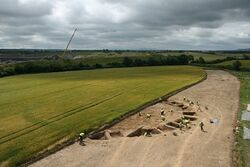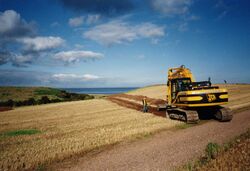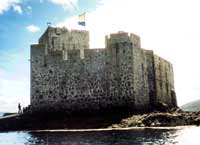Company:Headland Archaeology

| |
|---|---|
| Established | 1996 |
| Trading names | Headland Archaeology (UK) Ltd |
| Managing Director | Tim Holden |
| Location | Edinburgh, Silsoe (Beds.), Leeds, Hereford |
| Employees | c. 150 |
| Web | Homepage |
Headland Archaeology comprises a holding company Headland Group Ltd[1] and the trading subsidiary Headland Archaeology (UK) Ltd.[2] These companies provide archaeological services and heritage advice to the construction industry.
Company history
Headland Archaeology Ltd was established in 1996.[3] Headquartered in Edinburgh, this company expanded as a provider of commercial archaeology services in the UK. Expansion into the Irish market led to the establishment of Headland Archaeology (Ireland) Ltd in 2000,[4] in Co. Cork.
Restructuring of the companies in May and June 2008 involved the renaming of Headland Archaeology Ltd as Headland Group Limited. A new company, Headland Archaeology (UK) Limited,[3] was founded at this time to give, in conjunction with Headland Archaeology (Ireland) Ltd, a coherent structure to the group based on trading areas.
The acquisition of Hereford-based Archaeological Investigations Ltd in 2010 [5] expanded their UK operation. Archaeological Investigations Ltd was subsequently assimilated as a regional office of Headland Archaeology (UK) Limited by October of the same year,[6] with the underlying company dissolved in September 2012.[7] The company opened a South East office in 2011, initially in Leighton Buzzard later moving to Silsoe, Beds and a Northern office based in Beeston, Leeds in 2015.
During December 2011 a management buyout of Headland Archaeology (Ireland) Ltd with the Irish company renamed as Rubicon Heritage Services.[8]
Registered archaeological organisation
By 2001 Headland Archaeology Ltd had become a Registered Archaeological Organisation[9] with the Institute for Archaeologists given the reference number RAO40. This registration has been continued since this time and was transferred to Headland Archaeology (UK) Limited during the company re-organisation in 2008. The changing Irish operations of Headland Archaeology never fell within this scheme.
Projects
The following are a selection of projects that the Headland Archaeology companies have been involved with. Note that some of these projects were delivered by Headland Archaeology (Ireland) Ltd which has now left the group.
Major projects
UK
- M74 northern extension to M8, 19th century urban and industrial sites[10]
- Scottish Parliament, Edinburgh [11]
- The Newbridge chariot, Edinburgh[12]
- Verreville Glass and Pottery Works, Glasgow [1]
- The Inchmarnock Project, monastic settlement, Argyll and Bute[13]
- The Whithorn Project, Medieval Priory [2]
Ireland
Archaeological excavations
- Dubton Farm, Brechin, Angus. A wood-lined souterrain inside an Iron Age roundhouse.[15]
- Balblair Cist, Beauly, near Inverness, Bronze Age burial cairn[16]
- Bewell Street, Hereford
- Burgh by Sands, Aballava, Hadrian Wall Roman fort
- Carrowkeel, N6 road scheme, Ireland. Early Christian and Medieval settlement and cemetery[17]
- Cowgate, Edinburgh. Medieval town wall[18]
- Doune, Stirling, Roman fort[19] [5]
- Captain's Cabin, Dunbar, East Lothian, multi-phase settlement[20] [6]
- Cathedral Close, Hereford Cathedral [21]
- Gasswater, East Ayrshire, medieval turf building[22]
- Giles Street, Leith, Edinburgh. Medieval remains [7]
- Holm, Inverness, Bronze Age cists [8]
- Grassmarket, Edinburgh[9]
- Hackness battery, Longhope, Orkney [10]
- Shanzie Souterrain, Alyth, Perthshire. Iron Age underground structure[23] [11]
- Straiton Quarry, Newport-on-Tay, Fife. Bronze Age cremation burials
- Park Square Campus, University of Bedfordshire, Luton [12][13] [14]
- Perceton, North Ayrshire, Medieval Manor[24] [15]
- Upper Forth Crossing, Kincardine, Clackmannan. Prehistoric and Medieval remains
- Queensferry Crossing, Edinburgh and Fife. Mesolithic, Neolithic, Bronze Age, and Medieval remains [25]
Environmental archaeology
- Clonycavan Man, Ireland
- Geoarchaeological Regional Review of Marine Deposits along the Coastline of Southern England[26]
- Isle of Bute Master Chronology
- Newrath, Co. Kilkenny, multi period wetland site
- N9/N10 Kilcullen to Waterford scheme, pH analysis of burnt mounds
- Old Croghan Man, Ireland
- Ötzi, The Tyrolean Ice man, analysis of his last meal[27]
Heritage management
- The Irish Battlefields Project[16]
- Ewyas Harold Priory, Herefordshire[28]
Historic buildings
- The Arnol Blackhouses, Isle of Lewis[29] [17]
- The Dirleton Radar Station, East Lothian[30] [18]
- Dunnet, Brotchie's farm steading, Caithness[31] [19]
- Gasworks, Kilkenny, Ireland. Retort house
- Kerse House, Grangemouth,[32] country house of Sir Lawrence Dundas
- Kisimul Castle, Isle of Barra [20]
- Moirlanich Longhouse, Killin, thatching & vernacular building.[33]
- ROF Rotherwas, Hereford [21] [22] [23]
- Temple Mains Farm, Innerwick, farm steading, East Lothian [24]
- Waverley Mill, Galashiels [25]
Industrial archaeology
- Madelvic Works, Edinburgh [34]
- Mount Pleasant Pipeworks, Woodville[26],[35]
- Rotherwas Ordnance Factory, Hereford [27] [28]
- Shrubhill Tram Depot, Einburgh [36]
Maritime archaeology
- City of Adelaide clipper - laser scan[37] [29]
- Leamington Wharf, Union Canal, Edinburgh[38]
- A Zulu Herring Drifter at the Scottish Fisheries Museum - laser scan[37]
References
- ↑ Companies House
- ↑ Headland Archaeology Ltd - balancing culture and commerce,The Archaeologist, Summer 2010, No. 76
- ↑ 3.0 3.1 http://wck2.companieshouse.gov.uk Accessed 15 October 2012
- ↑ http://www.cro.ie Accessed 15 October 2012
- ↑ http://www.herefordshirepartnership.com/documents/Bulletin_-_May_10.pdf Accessed 20 September 2012
- ↑ http://www.headlandarchaeology.com/news.html Accessed 20 September 2012
- ↑ http://wck2.companieshouse.gov.uk/9ba416aa1c12dd145121924d8916501f/compdetails Accessed 20 September 2012
- ↑ http://www.archaeojobs.com/2011/12/headland-ireland-goes-independent-and.html Accessed 20 September 2012
- ↑ Institute for Field Archaeologists 2001 Yearbook and Directory. Cathedral Communications Ltd
- ↑ Drew, D, 2011 'The Glasgow I used to know', Henry Ling: Dorset
- ↑ Holyrood Archaeology Project Team (2008)Scotland's Parliament Site and the Canongate archaeology and history. Edinburgh: Society of Antiquaries of Scotland.
- ↑ Carter, S. and F. Hunter (2003), Antiquity 77, pp. 531-535.
- ↑ Lowe, Chris 2008 Inchmarnock. An Early Historic Island and its archaeological landscape, Society of Antiquaries of Scotland
- ↑ Eogan, J & Twohig, E (2011), Cois tSiuire - nine thousand years of human activity in the lower Suir Valley, NRA Scheme Monographes 8, National Roads Authority: Dublin
- ↑ Ginnever, Matthew (2017). "An Iron Age settlement and souterrain at Dubton Farm East, Brechin, Angus". Tayside and Fife Archaeological Journal 23: 1-12. http://www.tafac.org.uk/wp-content/uploads/2017/11/p1-12-Ginnever.pdf.
- ↑ Dutton, A., Clapperton, K. and S. Carter (2007). ‘Rock art from a Bronze Age burial at Balblair, near Inverness.’ Proceedings of the Scottish Society of Antiquaries 137, pp. 117-136
- ↑ B. Wilkins and S. Lalone (2009), 'An early medieval settlement/cemetery at Carrowkeel, Co. Calway.' The Journal of Irish Archaeology, vol. XVII, pp. 57-83.
- ↑ Dalland, M. (2004) '144-166 Cowgate.' Discovery and Excavation in Scotland, p. 52.
- ↑ Moloney, C. (1999) 'Doune Primary School, Doune (Kilmadock Parish), Roman Fort, Discovery and Excavation in Scotland p. 87
- ↑ Moloney, C. (2001) New evidence for the origins and evolution of Dunbar; excavations at the Captain's Cabin, Castle Park, Dunbar, East Lothian, Proceedings of the Society of Antiquaries in Scotland 131, pp. 283-318
- ↑ Boucher A, Craddock-Bennett L, & Daly T. 2015 Death in the Close: A medieval Mystery Edinburgh: Headland Archaeology
- ↑ Baker, L (2000) 'Gasswater Opencast Coal Scheme, Cronberry', Discovery and Excavation in Scotland, p. 23
- ↑ Coleman, R and Hunter, F (2002) "The excavation of a souterrain at Shanzie Farm, Alyth, Perthshire" Tayside and Fife Archaeological Journal vol 8 (2002), 77-101.
- ↑ Stronach, S et al. (2004) The Evolution of a Medieval Scottish Manor at Perceton, Near Irvine, North Ayreshire. J. Soc. Med Arch XLVIII.
- ↑ Robertson, Alistair; Lochrie, Julie; Timpany, Scott (2013). "Built to last: Mesolithic and Neolithic settlement at two sites beside the Forth estuary, Scotland". The Society of Antiquaries of Scotland 143: 73-136. doi:10.5284/1000184. http://archaeologydataservice.ac.uk/archives/view/psas/contents.cfm?vol=143. Retrieved 2017-01-22.
- ↑ Timpany, S, 2009 Geoarchaeological Regional Review of Marine Deposits along the coastline of Southern England. English Heritage, Research Department Report Series 4-2009 ISSN 1749-8775
- ↑ Holden, T G 2002 The food remains from the colon of the Tyrolean Ice Man, in Dobney, K & O’Connor, T (eds.) Bones and the Man: Studies in honour of Don Brothwell. Oxford: Oxbow Books. 35-40
- ↑ Kimber, M 2012 A Tale of Two Priories in Ewyas. Headland Archaeology (UK) Ltd. Edinburgh
- ↑ Holden T 2004 The Blackhouses of Arnol. Historic Scotland Research Report. Edinburgh
- ↑ Holden, T & Brown, I 2008 ‘A Wartime Legacy: Dirleton Radar Station’. Transactions of the East Lothian Antiquarian and Field Naturalists Society. XXVII, 117-130
- ↑ Holden, T 2003 'Brotchie's Steading (Dunnet parish), iron age and medieval settlement; post-medieval farm', Discovery Excav Scot, 4, 2003, 85-6.
- ↑ Robertson, A 2012 The rediscovery of ‘Carss Castell’: A medieval hall-house within, Kerse House, Grangemouth. Vernacular Building 36, pp. 41-60
- ↑ Holden, T G 2012 Moirlanich Longhouse, Killin: Changing techniques in thatching. Vernacular Building 35, 39-47.
- ↑ http://canmore.rcahms.gov.uk/en/site/258448/details/edinburgh+granton+87+granton+park+avenue+madelvic+car+factory+production+block/
- ↑ Cradock-Bennett, L (2007) ‘John Knowles & Co. Mount Pleasant Works, Woodville Woodlands’, Hereford Archaeology Series - Archaeological Investigation and history of the works, ref 757, 969.
- ↑ Bain, K (2008b) 'Shrub Hill Transport Depot, City of Edinburgh (Edinburgh parish), evaluation', Discovery Excav Scot, New, vol.9
- ↑ 37.0 37.1 Atkinson, D 2012 Laser Scan Survey and Historic Vessels, The IFA Yearbook Vol 12, pp. 18
- ↑ Coleman, R (2000), 'Union Canal, Leamington Wharf', Discovery and Excavation in Scotland, p. 57.
External links







